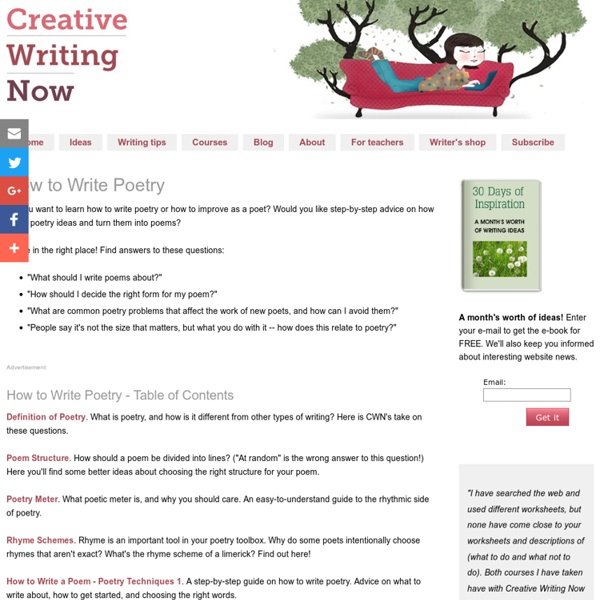How to Write Poetry - Creative Writing Lessons
Do you want to learn how to write poetry or how to improve as a poet? Would you like step-by-step advice on how to get poetry ideas and turn them into poems? You're in the right place! Find answers to these questions: "What should I write poems about?" Advertisement: How to Write Poetry - Table of Contents Definition of Poetry. Poem Structure. Poetry Meter. Rhyme Schemes. How to Write a Poem - Poetry Techniques 1. How to Write a Poem - Poetry Techniques 2. How to Write Poems - Poetry Techniques 3. Types of Poems - How to Write a Sonnet. Types of Poems - How to Write: Acrostic Poems, Blank Verse, Sestinas. Poem Types - How to Write a Narrative Poem or Ballad.. Poem Types - How to Write a Limerick. Poem Types - How to Write a Haiku. Poem Types - Found Poetry. Interview: Michael Klam on Poetry Slams. Interview: Karl Elder on Language Poetry. Interview: Jessie Carty on Narrative Poems. Online Writing Course - Essentials of Poetry Writing.
Benefits of Journaling
Updated December 15, 2014. Journaling is a term coined for the practice of keeping a diary or journal that explores thoughts and feelings surrounding the events of one’s life. Journaling, as a stress management and self-exploration tool, is not the same as simply recording the happenings in one’s life, like keeping a log. What Are The Benefits of Journaling? Journaling allows people to clarify their thoughts and feelings, thereby gaining valuable self-knowledge. As for the health benefits of journaling, they've been scientifically proven. Journaling decreases the symptoms of asthma, arthritis, and other health conditions. What Are The Drawbacks to Journaling? Those with learning disabilities may find it difficult to deal with the act of writing itself. How Does Journaling Compare to Other Stress Management Practices? Unlike more physical stress management techniques such as yoga or exercise, journaling is a viable option for the disabled. Email This Page To A Friend Sources:Anderson CM.
Creative Writing 101: A Beginner's Guide
Creative writing is any form of writing which is written with the creativity of mind: fiction writing, poetry writing, creative nonfiction writing and more. The purpose is to express something, whether it be feelings, thoughts, or emotions. Rather than only giving information or inciting the reader to make an action beneficial to the writer, creative writing is written to entertain or educate someone, to spread awareness about something or someone, or to express one’s thoughts. There are two kinds of creative writing: good and bad, effective and ineffective. So whether you’re a novelist, a poet, a short-story writer, an essayist, a biographer or an aspiring beginner, you want to improve your craft. When you write great fiction, poetry, or nonfiction, amazing things can happen. The best way to increase your proficiency in creative writing is to write, write compulsively, but it doesn’t mean write whatever you want. So here you have it, a beginners’ guide from Writers’ Treasure: Services
Written in the stars: the art of the bad review
Today marks the 50th anniversary of the New York Times restaurant review. We're honoring the art of criticism in a series on the subject. It took Jay Rayner around 700 words to lay waste to a Russian empire. In a blistering review of famed Moscow restaurateur Arkady Novikov's eponymous London outpost this past February, the Observer critic pronounced the establishment so "astoundingly grim you want to congratulate the kitchen on its incompetence" and compared its cuisine to cheap Chinese food. He was just getting warmed up. “And so my advice to you. Harsh words, but for a professional restaurant critic, this was par for the course. “You still have a basic job to do; you’ve got to get it right, and that’s what people expect,” says Rayner, whose eBook “My Dining Hell: Twenty Ways To Have a Lousy Night Out” will be released on June 1. Hanna Raskin, the restaurant critic for Seattle Weekly, also agrees critics do not go to a restaurant because they know it’s going to be abysmal.
SporeStory: Write Interactive Story
Locus Online - Zine of Sci-Fi & Fantasy
Related:
Related:



